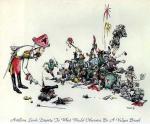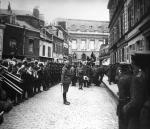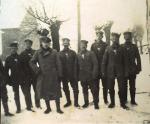-
Posts
5,629 -
Joined
-
Last visited
Content Type
Profiles
Forums
Blogs
Gallery
Events
Store
Everything posted by IrishGunner
-
Unfortunately, the original is fairly blurry too; it's on a post card, but only takes up about a third of the area. I am almost certain the ribbons are not EK black; they appear as almost all white in the photograph. (Would black EK ribbons washout to white in a photo of this era?) Under x9 magnifying loop, I can see that the two ribbons on the left have a wider and lighter center stripe with narrower darker side stripes; suggesting to me that it's possible they are Bavarian MVK. Another possibility would be the Wuerttemburg Military Merit Medal. The problem is that I can't really make out any of the shapes of the medals; nothing comes clear as a EK shape. Nothing really looks round either. So, it's a pure guess really, but I think they are Bavarians. Curious if anyone has evidence of an en masse awarding of the MVK. Seems logical.
-
Roll of Honor: The following officers and soldiers have been identified as being part of Fuß-Artillerie-Regiment von Linger (Ostpreußisches) Nr.1. Oberstleutnant Neumann; Regiments-Kommandeur (1914) Oberstleutnant Richard; reported to have attended the Lehrgang für ältere Offiziere bei der Fußartillerie-Schießschule vom 20. November bis 18. Dezember 1904 Major Friese; reported to have attended the Lehrgang für ältere Offiziere bei der Fußartillerie-Schießschule vom 20. November bis 18. Dezember 1904 Leutnant d. Rsv Bering, Walter; KIA 1918-10-24; Burial Giżycko, Poland Leutnant Ernest, Leop.; KIA 1914-11-2?; Burial Paprotki, Poland Vizefeldwebel Albrecht, Gustav; KIA 1915-02-12; Burial Biała Piska; Poland Obergefreiter Fiedler; KIA 1915-04-29; Burial Białaszewo, Poland Kanonier Marquardt; KIA 1915-03-08; Burial Białaszewo, Poland
-
It appears that II. Batl./Fußart. Regt. 1 may have remained on fortress duty; the 5. and 6. Batteries may have remained in Königsberg, while the II. Battalion Staff with the 7. and 8. Batteries remained in Lötzen within Festung Boyen. Elements of the II. Battalion would have seen initial combat during the Russian siege of Festung Boyen. Finished in 1848, Festung Boyen was built to defend East Prussia against potential threats from northeastern Russia and the Baltic region. The fortress defense system was reinforced by the natural geography of the Masurian Lakes and rivers. As the Russians advanced into East Prussia, they had to maneuver through the Masurian Lake region and they had to deal with Festung Boyen. Russian troops began a siege of the fortress; however, the German commander, Oberst Busse refused to capitulate. After the Russian defeat at Tannenberg, the Russians lifted the siege and withdrew from the area. After mobilization, it appears a third battalion was formed; III.Batl./Fußart.Regt.1 (2 Battr. 21Cm-Mörser). These batteries appear to have been numbered 5. and 6.; these are the same numbers of the units remaining behind in Königsberg. It is not clear if these batteries moved from Königsberg or were simply designated from newly mobilized batteries. The III Battalion was designated for 3. Armee on the Western Front and probably first deployed near the Meuse River in Belgium. After Germany's defeat in WWI, traditions of the Fuß-Artillerie-Regiment von Linger (Ostpreußisches) Nr.1 were taken over by the Reichswehr 1. (Preußisches) Artillerie-Regiment, 5. Batterie.
-
On 17 August 1914, I.Batl./Fußart.Regt.1 (Schwere Feldhaubitzen) and Munitions Kolumn Abteilung/I. Battalion, were mobilized as part of I. Armee Korps. At the same time, I. Armee Korps came under the command of 8. Armee on the Eastern Front. I. Battalion, Fuß-AR 1, with its heavy field howitzers, would have moved from its garrison at Königsberg upon mobilization, remaining on the Eastern Front with the I. Armee Korps. On 17 August instead of withdrawing from the Russian offensive as ordered, I. Armee Korps turned and won a victory over three Russian divisions at Stalluponen; I. Armee Korps then withdrew to Gumbinnen. On 19 August, the Russian Second Army continued into East Prussia south of the Masurian Lakes, and on 20 August, I. Armeekorps fought the Russians to a draw at the Battle of Gumbinnen. I. Battalion likely participated in these battles and the later German victory at Tannenberg, which was fought between 26-29 August with I. Armeekorps attacking the Russian left flank as one of the pincers surrounding the Russian Second Army. Interestingly, artillery played a curious part in the preparations of I. Armee Korps for the battle at Tannenberg. Despite some success at Gumbinnen, the German commander withdrew his forces to positions east of the Masurian Lakes, near Tannenberg. As a result, Hindenburg and Ludendorff were given command of the Eastern Front; they were intent on not giving up anymore East Prussian territory and began setting a trap for the Russians, who continued to advance into the dangerous terrain of the Masurian Lakes. Hindenburg and Ludendorff repositioned their forces to take advantage of the restrictive terrain around the Masurian Lakes, sending the I. Armee Korps by train to form the right wing of the planned encirclement of the Russians. On 25 August, Ludendorff issued an order to the I. Armee Korps commander, General Francois, to initiate the attack on the Russian left wing at Usdau. However, Francois resisted the order, preferring to wait at least until 27 August when he expected all of his artillery to complete its rail movement and be in position to support the attack. Ludendorff repeated the order; this time Francois reluctantly agreed to begin the attack despite not having enough ammunition for his artillery. In the meantime, the Germans intercepted two unencrypted messages transmitted by the Russians. The messages revealed that the Russian First Army would not be in position to support the Russian Second Army, the objective the German encirclement. As a consequence, Hindenburg decided that Francios could wait for the arrival of sufficient artillery support before beginning his attack. Ludendorff, on the other hand, was intent to assert his command over Francois and insisted that the attack still begin as planned. However, Francois continued to delay until he was satisfied that his artillery support was in place, finally beginning his attack on the left flank of the Russian Second Army on 27 August. I. Armee Korps achieved overwhelming success; however, Francois had lost the confidence of Hindenburg and Ludendorff and was relieved of command a short time later. The I. Armeekorps continued the fight in the First Battle of the Masurian Lakes and was an instrumental part of 8. Armee's expelling the Russians from East Prussia. It is likely that the I. Battalion/Fuß-AR 1 contributed to all of the early victories of I. Armee Korps.
-
Fuß-Artillerie-Regiment von Linger (Ostpreußisches) Nr.1; Fuß-AR 1 Garrison:Königsberg i. Preussen Established: 16.6.1864 Armee Korps: I. Armee Korps; Prussian 2. Fuß-Artillerie Brigade Uniform: Collar/cuffs - Black Brandenburg w/ Blue Vertical Panel; White shoulder straps with a red 1; Pickelhaube wappen - Gilt 1st Pattern Grenadier Eagle. This Commemorative Medal was likely issued on the Regiment's anniversary, 16 June 1914, only a short time before being mobilized. It was probably a very exciting time to be in the Regiment, celebrating 50 years of service to the Kaiser and preparing to defend the Fatherland against the growing storm. Prior to mobilization, Fuß-AR 1 was subordinate to the I. Armee Korps and the Prussian 2. Fuß-Artillerie Brigade. The Regimental Staff, I. Battalion, along with the 5. and 6. Batteries of II. Battalion were garrisoned at Königsberg in East Prussia (present day Kaliningrad, Russian Federation). The II. Battalion Staff, along with its 7. and 8. Batteries manned the Festung Boyen at Lötzen (present day Giżycko in northeastern Poland).
-
This is a brief history and other data about the Fuß-Artillerie-Regiment von Linger (Ostpreußisches) Nr.1. I have started this long-term project as part of my quest to build a collection representing all the Imperial German field and foot artillery regiments. For this regiment I have a Commemorative Medal; a regimental commemorative celebrating 50 years of the Fuß-Artillerie-Regiment von Linger (Ostpreußisches) Nr.1, 1864-1914. I bought this almost three years ago; unfortunately, I can't post a scan - the medal is in a safe deposit box a few thousand miles away. Maybe another day. Critiques and comments welcome. Even better if you can add something to the story. I don't intend to plagiarize as all of the information has been found on the internet; I lack any written references to the regiment (and am not sure a regimental history or Ehrenbuch even exists). Websites that have yielded information on Fuß-Artillerie-Regiment von Linger (Ostpreußisches) Nr.1 follow: http://www.festeboyen.pl/ http://www.1914-18.info/ http://www.axishistory.com/ http://www.firstworldwar.com/ http://www.polegli.tgcp.pl/ http://www.generalstafflibrary.com/
-
You should have posted these for me sooner, Chris. Seeing the real thing really helps make sense of the firing procedure. After I wrote the draft, I went back to look at the original photos at the beginning of this thread; after getting into the details of the weapon, the photos really came to life.
-
A lot going on in this photo: The band is wearing spiked pickelhauben, but the band leader is wearing an artillery ball pickelhauben. There is a jager shako on the left side of the procession. On the right side of the street are a couple sanitatsdienst. In the foreground is what appears to be a Landwehr gefreiter. Unfortunately, the award pillow is difficult to make out. Under magnification I can make out that there is what appears to be an aviator's badge on the left, an EK1 on the right; the medal bar center bottom has four medals - the first appears to be the EK2, the second is definately another cross and then two others. The neck decoration center top doesn't look like the PiM; the ribbon appears to be a dark center stripe with light side stripes. I know that doesn't help very much and the scan isn't that good; it's another one to strain the eyes. :whistle:
-
I got this photo thinking it was a group of new EK2's. However, upon closer inspection - both under jeweler's loop and with a scanned photo, I am pretty sure they are not/not EK's. I am not sure what decoration they may be instead. The ribbons are more light (not as black as would be for an EK), which made me think Bavarian. Under magnification, I thought I could discern both the Hamburg and the Lubeck ribbons. That might be an imagination working overtime. The shape of the medals themselves haven't become clear. So, I offer it here so you can strain your eyes for a bit. :whistle:
-
Actually a bit bizarre. One of the "pushers" seems to be a civilian with a white wide-brimmed hat (woman?). And on the far right of the group, there is man in civilian dress. I doubt it is training; seems to be a staged performance. The lack of smiling/laughing does suggest that it's not completely entertainment however. Physical training of some sort? Punishment?
-
Thanks, Chris; I thought you would have a good answer. I was pondering picking up a pre-war example to an artillery regiment. Another way to expand the regimental collection. (By the way, I received a nice Militarpass to an artilleryman in the mail recently. He started in a Feld-Artillerie Regiment before the war; looks like he was discharged to the reserves and then mobilized and spent the war in a Fuss-Artillerie Regiment. EKII and list of battles on the Western Front.)
-
Does anyone have info on a military document "Führungszeugnis"? Somehow translates as a "conduct certificate" or "leadership certificate"... Google searches turn up mostly modern usage - a certificate from the police on criminal record (or lack thereof). I have also found some TR references to such documents issued to soldiers, but very little on Imperial usage. I have seen a few with a time period pre-WWI, but haven't seen anything that dates such a document during the First World War. (Yes, posting on Christmas - teenagers still asleep! and wife chased me out of the kitchen!)
-

EK 1914 Fake EK doc...
IrishGunner replied to Chris Boonzaier's topic in Germany: All Eras: The Iron Cross
I was looking at this one the other day. Didn't realize it's fake. If it had been an artilleryman, I might have been bitten. Thanks for the tip. -
As a long-time Redleg, I'm with McSwiggan on this one; BTN1 is somehow corrupted from BTRY. I have absolutely no idea what BTN1 could mean; I've tried to rack my head as to the possibility that it's a "section" within SVC Btry, but can't think of anything. Assuming we are talking about an old helmet here - WWII? - here's a link to a 1944 artillery service battery's organization. Nothing that suggests a BTN1 to me... http://docs.google.com/viewer?a=v&q=cache:llGuXCW5WpwJ:www.militaryresearch.org/6-169%252022Nov44.pdf+artillery+OR+organization+%22service+battery%22&hl=en&sig=AHIEtbTXxusKRvfq8XqmrStcW_1X7kaKgg





